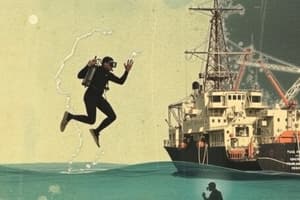Podcast
Questions and Answers
What primary factor contributed to the crane hook striking the diver's helmet during the subsea operation?
What primary factor contributed to the crane hook striking the diver's helmet during the subsea operation?
- Inadequate length of the crane pennant/stinger, combined with poor visibility. (correct)
- The crane operator's lack of experience in subsea lifting operations.
- Failure to conduct a pre-operation inspection of the diving helmet.
- The diver's failure to maintain a safe distance from the pipe handling frame (PHF).
Which of the following actions would be MOST effective in preventing a recurrence of the incident described?
Which of the following actions would be MOST effective in preventing a recurrence of the incident described?
- Increasing the frequency of inspections for diving helmets.
- Mandating additional training for divers on emergency response procedures.
- Implementing enhanced visibility aids and reinforcing clear communication protocols. (correct)
- Restricting subsea tie-in operations to daytime only.
Why did the crane operator assume the hook had reached the seabed?
Why did the crane operator assume the hook had reached the seabed?
- The crane operator relied on pre- Dive Hazard Analysis to make assumptions.
- The crane operator erroneously interpreted a 'no weight' reading as the hook being on the seabed after it rested on the PHF. (correct)
- The diving supervisor visually confirmed the hook's position.
- The crane wire had reached its maximum extension limit.
In the context of this incident, what does 'challenging assumptions' primarily refer to?
In the context of this incident, what does 'challenging assumptions' primarily refer to?
What key aspect of the diving equipment is highlighted despite the incident?
What key aspect of the diving equipment is highlighted despite the incident?
Flashcards
Subsea Crane Hook Incident
Subsea Crane Hook Incident
During subsea spool tie-in operations, a crane hook unexpectedly struck a diver's helmet due to the crane operator assuming the hook had reached the seabed.
Causes of Crane Incident
Causes of Crane Incident
Inadequate crane pennant length and poor visibility hindered accurate observation of the hook's position, leading to the incident.
Preventative Actions
Preventative Actions
Ensure adequate distance, enhance visibility with tools like underwater cameras, and reinforce clear communication and confirmation procedures.
Job Hazard Analysis (JHA)
Job Hazard Analysis (JHA)
Signup and view all the flashcards
Enhancing Subsea Visibility
Enhancing Subsea Visibility
Signup and view all the flashcards
Study Notes
- During subsea spool tie-in operations, a crane hook unexpectedly struck a diver's helmet.
What Happened
- During subsea spool tie-in operations in poor visibility, divers were working on the seabed.
- After landing the pipe handling frame (PHF), the Diving Supervisor ordered the crane operator to lower the crane hook to allow the diver to disconnect rigging.
- When the crane operator reported 'no weight', the Diving Supervisor assumed the hook reached the seabed and instructed the diver to disconnect the PHF.
- As the diver moved to disconnect the rigging, the crane hook unexpectedly struck the diver's helmet.
- The diver was unharmed and returned to the dive bell, and the dive was aborted.
- Inspection revealed the diver's reclaim helmet was damaged beyond repair, including the side block.
- The helmet's integrity was maintained, demonstrating the high quality and durability of the diving helmets.
- The diver was unharmed.
What Went Right
- Diver 2 helped Diver 1, ensuring no injuries.
- Both divers returned to the bell safely.
- Both divers and the crane block had locating beacons for accurate tracking.
- Procedures, lifting plans, and Job Hazard Analysis (JHA's) were followed.
- The protective equipment protected the diver from injury.
What Went Wrong
- The crane hook landed on the PHF's top beam during disconnection, resulting in a 'no weight' reading.
- The crane operator incorrectly assumed the hook was on the seabed.
- As the diver approached the disconnection point, the hook slipped and hit the diver's helmet.
What Was the Cause
- The crane pennant/stinger's length was inadequate, not providing enough distance between the divers and the crane hook.
- Visibility was poor, hindering the ability to see the crane hook.
Lessons and Actions
- Maintain adequate distance between divers and crane hook by using a sufficiently long crane pennant/stinger to reduce contact risk in low visibility.
- Use enhanced visibility aids and monitoring:
- Use alternative methods like additional locating beacons, underwater cameras, or sonar to better track the position of crane hook and critical equipment in poor visibility.
- Reinforce communications, challenge assumptions by:
- Minimising assumptions regarding equipment position.
- Reinforce clear communication and confirmation between the dive supervisor, crane operator, and divers to ensure awareness of equipment location.
- Updated project procedures now specify minimum pennant lengths for different operations.
- Pre-operation inspections of rigging and lifting equipment, including crane hooks and pennants, are conducted to ensure safety standards.
- The Job Hazard Analysis (JHA) was updated to include lessons learned about safe distances, visibility, and communication for subsea lifting operations.
Studying That Suits You
Use AI to generate personalized quizzes and flashcards to suit your learning preferences.




